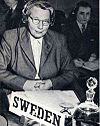Minister of Supply (Sweden)
| Minister of Supply of Sweden | |
|---|---|
| Folkhushållningsminister | |
 | |
| Ministry of Supply | |
| Appointer | The Prime Minister |
| Term length | No fixed term Serves as long as the Prime Minister sees fit |
| Formation | 15 October 1939 |
| First holder | Herman Eriksson |
| Final holder | John Ericsson |
| Abolished | 30 June 1950 |
The Minister of Supply[1] (Swedish: Folkhushållningsminister) was a member of the government of Sweden. The minister of supply was the head of the Ministry of Supply from 1939 to 1950 which handled matters relating to the national economy.
History
[edit]The minister of supply headed the Ministry of Supply which was established on 15 October 1939 to deal with administrative matters concerning general guidelines for the government's activities to ensure the supply within Sweden of necessities that were important for the population or production.[2] Herman Eriksson was entrusted with the task of organizing the new ministry, for matters relating to the national economy, of which Eriksson became the first head. This was perhaps Eriksson's greatest and for Sweden's most significant contribution at this time. As his successor in the position of minister of supply expressed himself about its organization, "it was so expedient and well adapted to the demands of the crisis situation that the whole thing could later be seen as self-evident".[3] Eriksson was succeeded by Axel Gjöres in 1941, who held the position for 6 years. Gjöres in turn was replaced by Gunnar Sträng in 1947. Gjöres had made very important contributions as minister both during the war and in the years immediately after. He did not want to leave the post in 1947, because the Swedish economy was in a very precarious situation.[4]
Gunnar Sträng had been persuaded to become minister of supply. He was then given responsibility for the regulatory policy that was maintained for several years after the Second World War, when it was feared that the depression would strike like after the First World War. That was not the case. Unemployment on a national basis was low, and prices were reasonably kept in order.[5] Gunnar Sträng was succeeded by Karin Kock who became Sweden's first female cabinet minister.[6] In December 1949, Prime Minister Tage Erlander forced Kock to leave her ministerial post to become director general of Statistics Sweden. She was not happy about the change and would have liked to stay, something Erlander had a hard time understanding, considering that her influence had been reduced to insignificance. Erlander had instead wanted Axel Strand, the head of the Swedish Trade Union Confederation, as minister of supply. He declined, however and John Ericsson took over the post for six months before the ministry and thus the post ceased on 30 June 1950.[7][8]
List of officeholders
[edit]- Color key
Independent
Historical parties:
Lantmanna
Moderate
National Party
Liberals
Liberals
Liberals
Liberals
Present parties:
Social Democrats
Moderate
Centre
Left
Liberals
Christian Democrats
Green
Sweden Democrats
| 1939–1950 | ||||||||
|---|---|---|---|---|---|---|---|---|
| Portrait | Minister (Born-Died) |
Term | Political Party | Coalition | Cabinet | |||
| Took office | Left office | Duration | ||||||
| Herman Eriksson (1892–1949) [3] | 15 October 1939 | 7 March 1941 | 1 year, 143 days | Social Democrats | S/SAP–C | Hansson II | ||
| Axel Gjöres (1889–1979) [9][10] | 7 March 1941 | 7 April 1947 | 6 years, 31 days | Social Democrats | S/SAP–C–L–M | Hansson III Hansson IV Erlander I | ||
| Gunnar Sträng (1906–1992) [11] | 11 April 1947 | 28 October 1948 | 1 year, 200 days | Social Democrats | – | Erlander I | ||
| Karin Kock-Lindberg (1891–1976) | 29 October 1948 | 31 December 1949 | 1 year, 63 days | Social Democrats | – | Erlander I | ||
| John Ericsson (1907–1977) | 1 January 1950 | 30 June 1950 | 180 days | Social Democrats | – | Erlander I | ||
References
[edit]Notes
[edit]- ^ Gullberg 1977, p. 226.
- ^ Lorents 1939, p. 683
- ^ a b Hemming 1953, p. 410
- ^ Åsbrink 2019
- ^ Lassinantti 2018
- ^ Hedman, Wegelius & Sundin 2008, pp. 24–25
- ^ Harrison 2017
- ^ Bergelin 1951, p. 741
- ^ Bramsen 1944, p. 170
- ^ Rudberg 1948, p. 68
- ^ Johansson 2007–2011, p. 765
- Bergelin, S.-E. S., ed. (1951). Nordisk familjebok: encyklopedi och konversationslexikon (in Swedish). Vol. 7 (4th ed.). Malmö: Förlagshuset Norden. SELIBR 539090.
- Bramsen, Bo, ed. (1944). När var hur: aktuell årsbok 1945 (in Swedish). Stockholm: Åhlén & Åkerlund. SELIBR 8261509.
- Gullberg, Ingvar E. (1977). Svensk-engelsk fackordbok för näringsliv, förvaltning, undervisning och forskning [A Swedish-English dictionary of technical terms used in business, industry, administration, education and research] (in Swedish) (2nd ed.). Stockholm: Norstedt. ISBN 91-1-775052-0. SELIBR 8345587.
- Hedman, Rune; Wegelius, Jakob; Sundin, Maria (2008). Regeringskansliet genom tiderna (in Swedish) (2nd ed.). Stockholm: Regeringskansliet. SELIBR 10900616. Archived from the original on 22 April 2022.
- Harrison, Dick (2017). Jag har ingen vilja till makt : biografi över Tage Erlander (in Swedish). Stockholm: Ordfront. ISBN 9789174416466. SELIBR 21711885.
- Hemming, Sten J:r. (1953). "Gustaf Herman Eriksson". Svenskt biografiskt lexikon (in Swedish). Vol. 14. National Archives of Sweden. Retrieved 9 November 2022.
- Johansson, Anders L (2007–2011). "Gunnar Georg Emanuel Sträng". Svenskt biografiskt lexikon (in Swedish). Vol. 33. National Archives of Sweden. Retrieved 9 November 2022.
- Lassinantti, Gunnar (9 June 2018). "Från agitator till rikshushållare". Norrländska Socialdemokraten (in Swedish). Retrieved 9 November 2022.
- Lorents, Yngve, ed. (1939). Nordisk familjeboks månadskrönika (in Swedish). Vol. 2. Stockholm: Nordisk familjeboks förlag. SELIBR 3680139.
- Rudberg, Erik, ed. (1948). Svenska dagbladets årsbok TJUGOFEMTE ÅRGÅNGEN (Händelserna 1947) (in Swedish). Stockholm: Svenska dagbladet. SELIBR 283647.
- Åsbrink, Erik (2019). Gunnar Emanuel Sträng: med hängslen och livrem i välfärds-Sverige (in Swedish). [Stockholm]: Albert Bonniers Förlag. ISBN 9789100167523. SELIBR kt84z00nhmsxmxr3.

![Herman Eriksson [sv; gl]](http://upload.wikimedia.org/wikipedia/commons/thumb/7/73/G_Herman_Eriksson.jpg/100px-G_Herman_Eriksson.jpg)



![John Ericsson [sv]](http://upload.wikimedia.org/wikipedia/commons/thumb/7/72/Kinna_Ericsson.jpg/100px-Kinna_Ericsson.jpg)